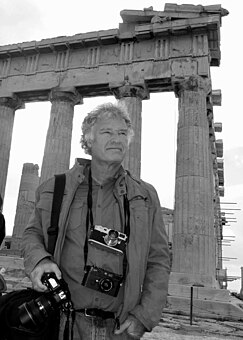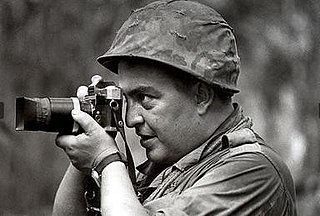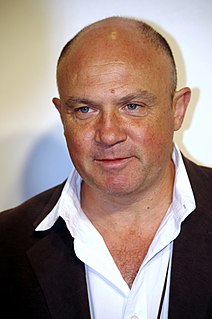Related Research Articles

The Pulitzer Prize for Breaking News Photography is one of the American Pulitzer Prizes annually awarded for journalism. From 2000 it has used the "breaking news" name but it is considered a continuation of the Pulitzer Prize for Spot News Photography, which was awarded from 1968 to 1999. Prior to 1968, a single Prize was awarded for photojournalism, the Pulitzer Prize for Photography, which was replaced in that year by Pulitzer Prize for Spot News Photography and Pulitzer Prize for Feature Photography.

This Pulitzer Prize has been awarded since 1942 for a distinguished example of reporting on international affairs, including United Nations correspondence. In its first six years (1942–1947), it was called the Pulitzer Prize for Telegraphic Reporting - International.
Getty Images, Inc. is a British-American visual media company and is a supplier of stock images, editorial photography, video and music for business and consumers, with an archive of over 200 million assets. It targets three markets—creative professionals, the media, and corporate.
Photojournalism is journalism that uses images to tell a news story. It usually only refers to still images, but can also refer to video used in broadcast journalism. Photojournalism is distinguished from other close branches of photography by having a rigid ethical framework which demands an honest but impartial approach that tells a story in strictly journalistic terms. Photojournalists contribute to the news media, and help communities connect with one other. They must be well-informed and knowledgeable, and are able to deliver news in a creative manner that is both informative and entertaining.

The Pulitzer Prize for Feature Photography is one of the American Pulitzer Prizes annually awarded for journalism. It recognizes a distinguished example of feature photography in black and white or color, which may consist of a photograph or photographs, a sequence or an album.

Tank Man is the nickname of an unidentified Chinese man who stood in front of a column of tanks leaving Tiananmen Square in Beijing on June 5, 1989, the day after the Chinese government's violent crackdown on the Tiananmen protests. As the lead tank maneuvered to pass by the man, he repeatedly shifted his position in order to obstruct the tank's attempted path around him. The incident was filmed and shared to a worldwide audience. Internationally, it is considered one of the most iconic images of all time. Inside China, the image and the accompanying events are subject to censorship.

Toshio Sakai was a Japanese photographer for United Press International. He was the very first winner of the Pulitzer Prize for Feature Photography.
Chris Hondros was an American war photographer. Hondros was a finalist twice for a Pulitzer Prize for Breaking News Photography.

Jeff Widener is an American photographer, best known for his image of the Tank Man confronting a column of tanks in Tiananmen Square in the aftermath of the Tiananmen Square protests of 1989 which made him a nominated finalist for the 1990 Pulitzer, although he did not win.

Horst Faas was a German photo-journalist and two-time Pulitzer Prize winner. He is best known for his images of the Vietnam War.

Greg Marinovich is a South African photojournalist, filmmaker, photo editor, and member of the Bang-Bang Club.
Demotix was a photo agency that enabled freelance photojournalists to license their photos to mainstream media organisations, charities, and stock image buyers.
George Rose is an American photographer and writer whose career has included work for the National Football League, Rolling Stone, Time, Life, Newsweek, Sports Illustrated, USA Today and the Los Angeles Times. He spent 20 years in the California wine industry, holding prominent public relations positions while amassing a significant body of award-winning food and wine photography.
Daniel Berehulak is an Australian photographer and photojournalist based in Mexico City. He is a regular contributor to The New York Times and has visited more than 60 countries covering contemporary issues.
Goran Tomašević, is a Serbian photographer. Working for Reuters, he has spent more than 20 years travelling around the globe to cover the world's biggest stories.
Paula Bronstein is a photojournalist who entered the profession in 1982 in Providence, Rhode Island. She is now based in Bangkok where she works for Getty Images. Bronstein was a nominated finalist for the Breaking News 2011 Pulitzer Prize.

Christopher Anderson is an American photographer. He is a member of Magnum Photos.
Thomas James Hurst is an American photographer, pastor, and entrepreneur/inventor.

Mohammad Kheirkhah Zoyari, also known as Moe Zoyari, is an Iranian-American photographer. He has won three Pictures of the Year International Awards.

Danish Siddiqui was an Indian photojournalist based in Delhi, who used to lead the national Reuters multimedia team. He received the 2018 Pulitzer Prize for Feature Photography, as part of the Reuters team, for documenting the Rohingya refugee crisis. In 2021, he was killed while covering a clash between Afghan security forces and Taliban forces near a border crossing with Pakistan.
References
This article includes a list of references, related reading or external links, but its sources remain unclear because it lacks inline citations .(August 2012) |
- Photography
- 'Sex for Sale' - Did Time Buy Some Phony Photos?
- Court Broadens Scrutiny in Time Libel Case
- Time Says Photographs of Moscow 'Child Prostitutes' Were Staged
- Getty Images expands editorial coverage to China
- Forbes.com [ dead link ]
- http://corporate.gettyimages.com/source/company/index.aspx?pageID=companyOfficers
- Afghan Photos
- http://www.ellisphotos.com/